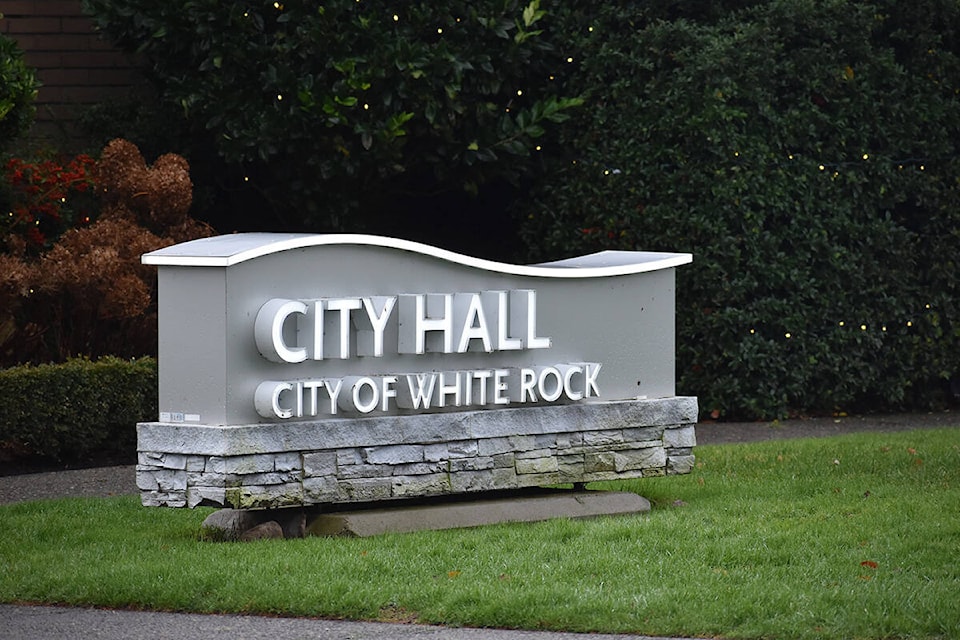White Rock council has approved spending close to $500,000 to move its meeting chambers out of overcrowded city hall and into the annex building on Fir Street.
The Jan. 29 motion from Coun. Elaine Cheung was approved by a majority vote, with Mayor Megan Knight and Couns. Bill Lawrence, Michele Partridge and Cheung in favour.
Couns. Christopher Trevelyan and Ernie Klassen voted against the motion, questioning the expenditure – which, Klassen noted, comes at a time when people with disabilities are being asked to fundraise for even $100,000 to make the pier accessible.
Coun. David Chesney, who was absent, also provided a statement opposing the “very expensive” move.
Plans are for the old chamber space to be renovated and refurbished to provide desperately-needed office space for staff, until the eventual creation of a new ‘Community Hub’ for council and city departments – which even an optimistic estimate places at least four years in the future.
At the Jan. 29 meeting, city engineer and operations manager Jim Gordon told council the move has been necessitated by council’s recognition of “inadequate and expanding operational space requirements.”
To improve service delivery to the community, council has called for hiring of additional staff – but, as Gordon pointed out, current space at city hall scarcely provides room for existing staff.
Three options were examined, Gordon noted.
One was to relocate the chambers to the White Rock Community Centre, and construct offices at a total cost – including lost revenue from recreation activities, classes and events at the centre – of some $370,000.
A second option was to construct offices in the annex and leave council chambers where they are, which would cost some $350,000. However, Gordon said the annex does not lend itself to office use, as the condition of the aging building can create allergy and other working-environment problems, which might make it even more difficult to attract and retain new staff.
Staff recommended relocating council chambers to the annex, and constructing offices in the vacated space, at a cost of between $430,000 and $480,000.
Gordon said this approach, unlike the others, required a ‘modest’ additional investment of $20,000 annually.
It was recommended as it would cause the least disruption to service of customers at city hall, and avoid a potential decline in quality of council meetings.
Knight agreed.
“There’s only one thing I would add to that is, let’s just keep the costs down – there’s no use putting a bunch of money into that building for us to be there two nights a month,” she said.
“So forego air conditioning, or acoustics, or whatever we can cut. Can we take the furniture out of here and put it there? Let’s not put tons of money into that thing – it’s going to be bulldozed eventually, anyway.”
Cheung suggested authorizing staff to proceed with the work immediately, rather than once the city’s financial plan is adopted.
In answer to a question from Knight, CAO Guillermo Ferrero said council chambers would likely be repurposed for corporate administration and finance-staff offices.
“Downstairs would be human resources, and the vacated spaces from corporate administration will become planning.”
Chesney, in a statement read by Trevelyan, disagreed with the suggested option, describing the expense as “unnecessary.”
“The temporary office space should be created in the annex building, where the very expensive proposal to relocate the council chambers is proposed,” he said.
Trevelyan said he couldn’t “get over a half-a-million dollar price tag.”
“You could build a house for that, or almost build a house for that – like the foundation and everything – so that, alone, is a barrier for me,” he said.
“I do appreciate the shortage of office space in this building, I get it,” he continued. “My concern is the position of the elected representatives of the city… being put into the dankest hole (where) I don’t want staff to go either, quite frankly, and the public to meet in there.”
He suggested using rooms in the community centre or Centre for Active Living.
Ferrero emphasized that putting council chambers into the annex would only be temporary.
“It’s not for all time,” he said. “Eventually we’ll bring the quality of the council chambers back to what it deserves.”
Partridge said she had no desire to second-guess staff.
“You’ve thought long and hard about this – you know what needs to be done,” she said.
“We’re a growing city and this needs to happen to attract quality staff – which is a challenge in every municipality. I think we can make do, for what is needed, for the future of White Rock.”
Klassen also voiced concerns about the cost, “especially when we’re talking about asking people with disabilities to fundraise $100,000 to make the pier accessible.”
Klassen floated the idea of whether, if offices were relocated to the council chamber space, council could have meetings in some other private outside facility, such as Blue Frog Studios, or churches in White Rock that receive a property-tax exemption.
“Let’s ask them for some services back to the city,” he suggested.
